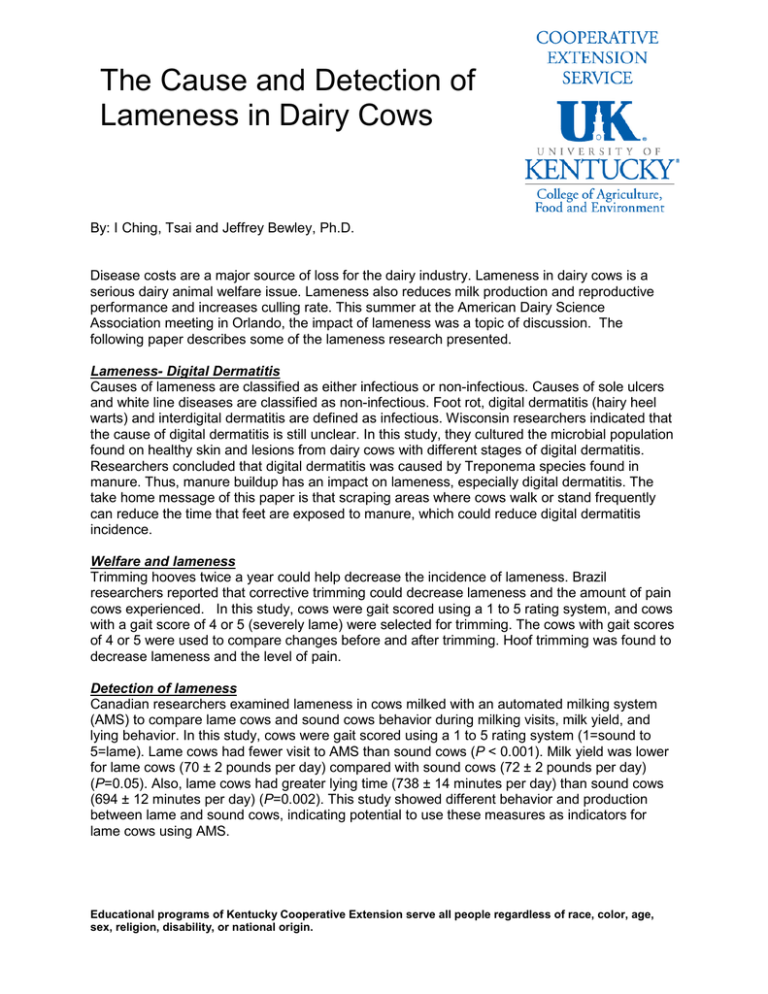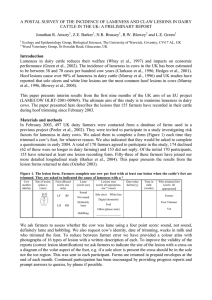The Cause and Detection of Lameness in Dairy Cows
advertisement

The Cause and Detection of Lameness in Dairy Cows By: I Ching, Tsai and Jeffrey Bewley, Ph.D. Disease costs are a major source of loss for the dairy industry. Lameness in dairy cows is a serious dairy animal welfare issue. Lameness also reduces milk production and reproductive performance and increases culling rate. This summer at the American Dairy Science Association meeting in Orlando, the impact of lameness was a topic of discussion. The following paper describes some of the lameness research presented. Lameness- Digital Dermatitis Causes of lameness are classified as either infectious or non-infectious. Causes of sole ulcers and white line diseases are classified as non-infectious. Foot rot, digital dermatitis (hairy heel warts) and interdigital dermatitis are defined as infectious. Wisconsin researchers indicated that the cause of digital dermatitis is still unclear. In this study, they cultured the microbial population found on healthy skin and lesions from dairy cows with different stages of digital dermatitis. Researchers concluded that digital dermatitis was caused by Treponema species found in manure. Thus, manure buildup has an impact on lameness, especially digital dermatitis. The take home message of this paper is that scraping areas where cows walk or stand frequently can reduce the time that feet are exposed to manure, which could reduce digital dermatitis incidence. Welfare and lameness Trimming hooves twice a year could help decrease the incidence of lameness. Brazil researchers reported that corrective trimming could decrease lameness and the amount of pain cows experienced. In this study, cows were gait scored using a 1 to 5 rating system, and cows with a gait score of 4 or 5 (severely lame) were selected for trimming. The cows with gait scores of 4 or 5 were used to compare changes before and after trimming. Hoof trimming was found to decrease lameness and the level of pain. Detection of lameness Canadian researchers examined lameness in cows milked with an automated milking system (AMS) to compare lame cows and sound cows behavior during milking visits, milk yield, and lying behavior. In this study, cows were gait scored using a 1 to 5 rating system (1=sound to 5=lame). Lame cows had fewer visit to AMS than sound cows (P < 0.001). Milk yield was lower for lame cows (70 ± 2 pounds per day) compared with sound cows (72 ± 2 pounds per day) (P=0.05). Also, lame cows had greater lying time (738 ± 14 minutes per day) than sound cows (694 ± 12 minutes per day) (P=0.002). This study showed different behavior and production between lame and sound cows, indicating potential to use these measures as indicators for lame cows using AMS. Educational programs of Kentucky Cooperative Extension serve all people regardless of race, color, age, sex, religion, disability, or national origin.







